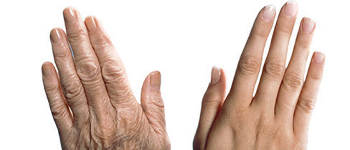Hand skin correction
 Our hands, as Dr. V. Mitz said, are precious gift but they also age with time. The first signs of hand skin aging appear quite early since, in addition to the natural processes of biological aging, the hand skin is subjected to constant influence of environment including UV-light irradiation.
Our hands, as Dr. V. Mitz said, are precious gift but they also age with time. The first signs of hand skin aging appear quite early since, in addition to the natural processes of biological aging, the hand skin is subjected to constant influence of environment including UV-light irradiation.
During aging, the skin on the back of hands becomes thin; the natural fat layer is destroyed and subcutaneous veins are protruded. As a result of chronic damage by the UV light, the signs of hyperpigmentation and solar lentigo appear on the hand skin, the skin turgor and elasticity is decreased, and wrinkles are formed on the hand skin.
Modern methods of correction of the age-related hand skin changes
The modern arsenal of methods to correct the age-related hand skin changes is sufficiently broad. These methods can be conditionally divided onto 3 groups. The first group includes surgical methods, out of which the most popular method is lipofilling, i.e., the subcutaneous transplantation of autologous fat in order to compensate the loss of soft tissues volumes during aging. The second group of methods includes the standard cosmetological methods, such as biorevitalizing (injections of hyaluronic acid preparations into the hand skin), plasma therapy, device methods (radio waves and laser technologies), microdermabrasion, and chemical peelings.
The aim of these methods is to stimulate the main skin components, fibroblasts, to work intensively (to produce collagen, elastin, and the other components of dermal extracellular matrix) and to compensate the lost volume of the derma. However, since with age the amount and activity of fibroblasts in the skin are decreased (according to the data of American scientists, collagen production in old people is decreased by approximately 75% as compared with the young people skin, whereas the total amount of fibroblasts is decreased by approximately 40% in average) the final result not always corresponds patients' expectations.
The efficient method of rejuvenation of the hand skin
The fundamentally different approach is used in the third group of methods belonging to the field of regenerative medicine. This group of methods includes the SPRS therapy. This method is based on injections into patient's skin his (or her) own fibroblasts which, being injected into the skin, regenerate the skin by triggering natural physiological mechanisms of skin regeneration. According to the morphological data, after transplantation, the cultivated autologous fibroblasts are entirely integrated into the derma; their biosynthetic activity is maintained at least for 12 months. As a result, the content of collagen fibers is increased in the skin, the skin thickness is increased, and the amount and depth of wrinkles are decreased, which promotes the restoration of hands beauty.
- Botox. Poison and current for face skin
- The SPRS therapy. Test on ourselves. Part 1
- Hyaluronic acid: for those who take risk
- How many the SPRS procedures should one take to achieve the optimal result? How often must they be repeated?
- What is the cost of the SPRS therapy course

